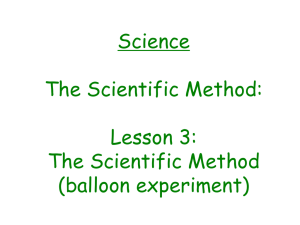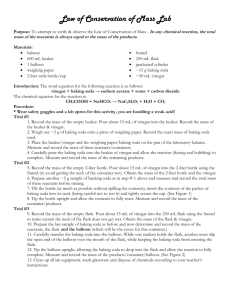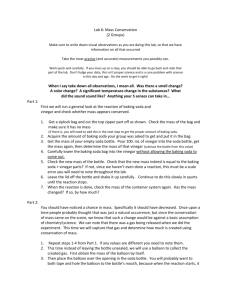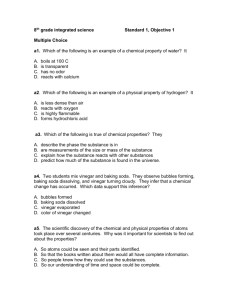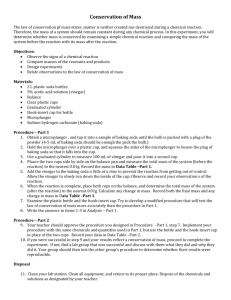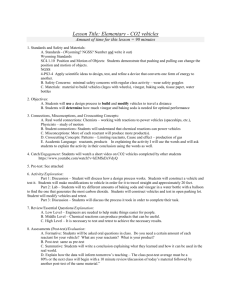Is This A Chemical or Physical Reaction
advertisement
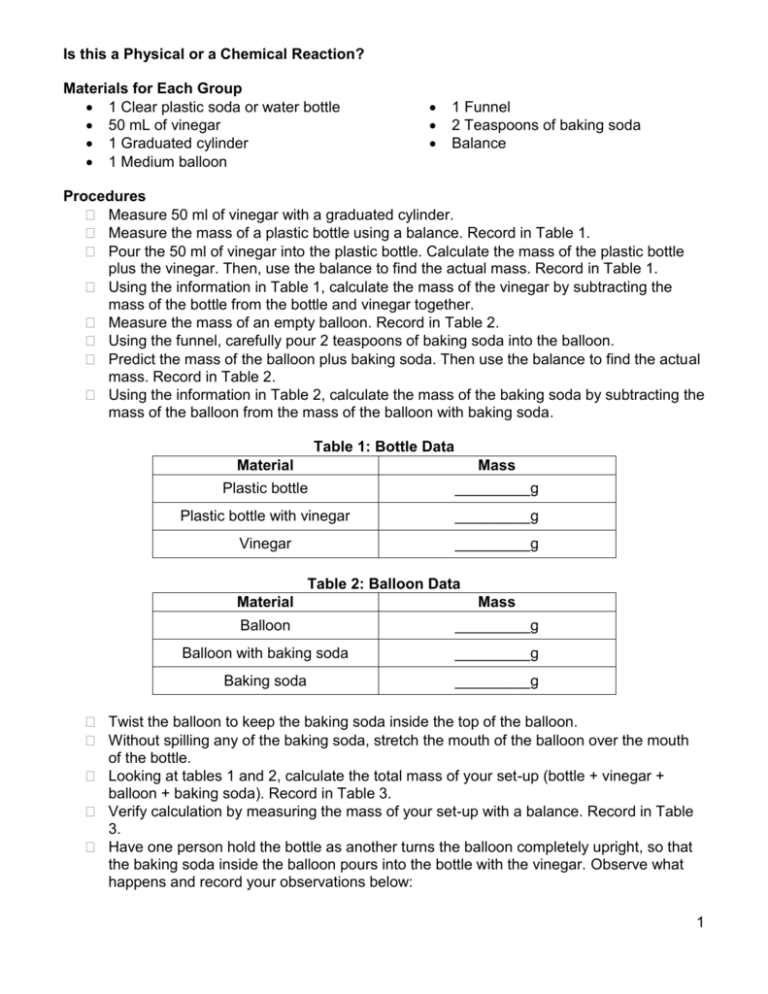
Is this a Physical or a Chemical Reaction? Materials for Each Group 1 Clear plastic soda or water bottle 50 mL of vinegar 1 Graduated cylinder 1 Medium balloon 1 Funnel 2 Teaspoons of baking soda Balance Procedures Measure 50 ml of vinegar with a graduated cylinder. Measure the mass of a plastic bottle using a balance. Record in Table 1. Pour the 50 ml of vinegar into the plastic bottle. Calculate the mass of the plastic bottle plus the vinegar. Then, use the balance to find the actual mass. Record in Table 1. Using the information in Table 1, calculate the mass of the vinegar by subtracting the mass of the bottle from the bottle and vinegar together. Measure the mass of an empty balloon. Record in Table 2. Using the funnel, carefully pour 2 teaspoons of baking soda into the balloon. Predict the mass of the balloon plus baking soda. Then use the balance to find the actual mass. Record in Table 2. Using the information in Table 2, calculate the mass of the baking soda by subtracting the mass of the balloon from the mass of the balloon with baking soda. Table 1: Bottle Data Material Mass Plastic bottle _________g Plastic bottle with vinegar _________g Vinegar _________g Table 2: Balloon Data Material Mass Balloon _________g Balloon with baking soda _________g Baking soda _________g Twist the balloon to keep the baking soda inside the top of the balloon. Without spilling any of the baking soda, stretch the mouth of the balloon over the mouth of the bottle. Looking at tables 1 and 2, calculate the total mass of your set-up (bottle + vinegar + balloon + baking soda). Record in Table 3. Verify calculation by measuring the mass of your set-up with a balance. Record in Table 3. Have one person hold the bottle as another turns the balloon completely upright, so that the baking soda inside the balloon pours into the bottle with the vinegar. Observe what happens and record your observations below: 1 Is this a Physical or a Chemical Reaction? Draw your Set-Up before adding baking soda Picture should have a deflated balloon attached to the bottle. Draw your Set-Up after adding baking soda Picture should have an inflated balloon attached to the bottle. 1. What two substances combined in the experiment? _____________________________ The vinegar and baking soda combined._______________________________________ 2. Did the baking soda and vinegar make a reaction? How do you know? Yes, the bubbles and the inflated the balloon are evidence of a chemical reaction.______ _______________________________________________________________________ _______________________________________________________________________ 3. Did the reaction form a new solid, liquid, or gas? Explain. Students should note the formation of gas. They may also report seeing the formation___ of a new solid and a new liquid.______________________________________________ _______________________________________________________________________ 4. Did the temperature of the bottle change? Explain. Students should feel that the bottle feels cooler during the reaction__________________ _______________________________________________________________________ _______________________________________________________________________ 5. What evidence is there that a chemical reaction has taken place? __________________ Bubbles indicate that a gas was formed causing the balloon to expand._____________ 2 Is this a Physical or a Chemical Reaction? The cooler temperature of the bottle is another indication that a chemical reaction has__ Taken place.___________________________________________________________ Carefully place the bottle (with the balloon still attached) on the balance. Record this mass in Table 3. Table 3: Data of Set-Up Mass of Set-Up Before (calculated) Plastic bottle + Balloon ____________ g Vinegar + Baking Soda ____________ g Total ____________ g Mass of Set-Up After (measured) ____________ g 6. Compare the total mass of your Set-Up before and after. What do you observe and what can you explain? _________________________________________________________ Answers will vary but the mass of the products should be approximately the same as___ the mass of the reactants.__________________________________________________ _______________________________________________________________________ _______________________________________________________________________ 7. Explain how this experiment shows that the mass of an object is equal to the sum of all its parts. The masses of reactants and products should be the same._______________________ _______________________________________________________________________ _______________________________________________________________________ 8. Give two reasons why the mass of the reactants in your experiment may not be exactly equal to the mass of the products. Answers may include: human error, spilled some of the baking soda, did not read______ balance correctly, balloon was not on tightly so some of the gas escaped.____________ _______________________________________________________________________ _______________________________________________________________________ 3 Is this a Physical or a Chemical Reaction? Teacher Notes: During the exercise, make sure to ask probing questions and find out what students understand from the process. This experiment is not designed to solve a problem statement, but to use the Nature of Science process to make observations, gather data, and reflect on the information collected. In a chemical reaction, the substances that you start with (the reactants) are different from the substances you finish with (the products). In this activity, the reactants were the baking soda (a pure substance) and vinegar (a solution). The products were a mixture of water, carbon dioxide, and a kind of salt called sodium acetate. Also, you have learned that the sum of the reactants (the Set-Up Before) was equal to (almost) the sum of the products (the Set-Up After). Some of the reasons why the two might not have been exactly equal are that (1) some of the carbon dioxide escaped, (2) the pan balance was not completely accurate, and (3) human error during the measuring of mass of the substances occurred. Examples that a chemical reaction is taking place are (1) color change, (2) formation of a gas, (3) formation of a solid, and (4) changes in temperature as a result of energy exchange. 4

